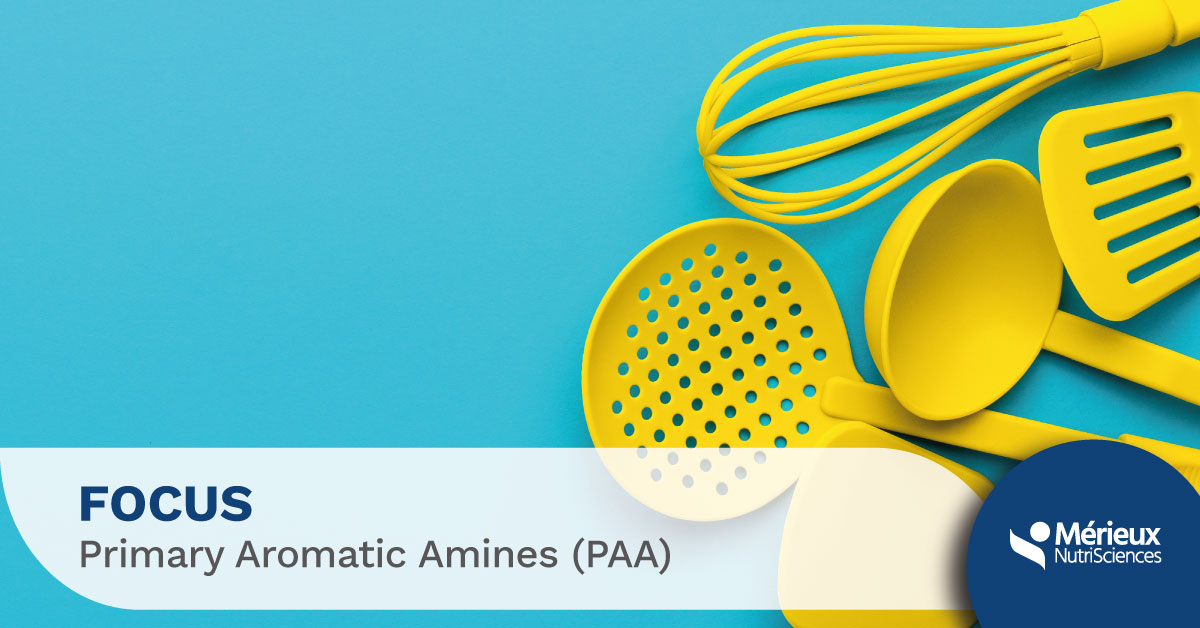PRIMARY AROMATIC AMINES (PAA)

WHAT ARE PRIMARY AROMATIC AMINES
Primary aromatic amines (or PAA for short) are chemical products derived from ammonia and are used in the pharmaceutical industry, to produce rubber, to dye fabrics, leather and paper, but also in the production of azo dyes and in the production of plastic materials. According to the International Agency for Research for Cancer (IARC) they fall into the category of substances that have known or potential carcinogenic effects for humans.
THE MIGRATION OF PRIMARY AROMATIC AMINES
For kitchen utensils, paper napkins and other food contact materials, primary aromatic amines can pose a health risk if they transfer to food and drink.
The problem was already known in 2011, when the Joint Research Center (JRC) published the guideline to verify the migration of PAA from polyamide tableware following the entry into force of EU Regulation no. 284/2011, which establishes adequate documentation and compliant analysis results for plastic tableware from China and Hong Kong.
According to research from the University of Zaragoza (Spain) conducted in 2013, food contact materials (FCM) are a source of contamination of unintended foods. These substances are referred to as non-intentionally added substances (NIAS), i.e. substances added unintentionally. NIAS essentially come from 3 sources:
- interaction between the constituents of the materials that make up the packaging;
- degradation processes;
- impurities of raw materials.
Unintentional contamination is also due to the fact that the packaging materials have a very complex structure and can undergo further processes: coating, gluing, coloring and lamination. It should also be considered that it is very difficult for producers to track their presence effectively along the entire production chain.
In 2019, the Danish Consumer Council (DCC) conducted a further study on food contact materials. In this research, 20 different types of disposable packaging were tested - such as coffee cups, straws and colored paper bags: in 4 cases the test demonstrated the presence of primary aromatic amines from the ink used during production.
Despite the regulatory gaps at EU level for most FCMs (food contact materials), the publication of EU Regulation no. 2020/1245 amending the EU Regulation no. 10/2011 concerning plastic materials and articles intended to come into contact with food, in which the detection limit of primary aromatic amines has been further lowered from 0.01 mg / kg to 0.002 mg / kg of food product or simulant .
The criticality is constantly monitored by the Safety HUD tool, which since January 2018 has collected 130 reports relating to food contact materials in which a migration of primary aromatic amines (PAA) has been identified above the established limits.
Data updated to 03/12/2021
Bibliography:
- https://publications.jrc.ec.europa.eu/repository/handle/JRC64903
- https://eur-lex.europa.eu/legal-content/IT/TXT/?uri=CELEX%3A32011R0284
- https://publications.jrc.ec.europa.eu/repository/handle/JRC64903
- https://www.foodpackagingforum.org/news/nias-detection-in-food-packaging...
- https://kemi.taenk.dk/bliv-groennere/test-unwanted-chemicals-colorful-fo...
- https://eur-lex.europa.eu/legal-content/IT/TXT/?uri=CELEX%3A32020R1245

